Omi beef / Japan
Raising the steaks
Omi beef from Shiga prefecture is little known outside Japan, but its butter-soft consistency and low fat content means that restaurateurs, meat producers and diners from New York to Australia are starting to take notice.
While Kobe beef has successfully exported its name around the world, Omi is hardly known outside Japan. And yet Omi is part of the triumvirate of marbled beef – along with Kobe and Matsuzaka – that has come to define the taste of wagyu (literally “Japanese beef”). All three are rooted in the same breed of Tajima long-haired black cows and yet somewhere along the way Omi lost out on the marketing front. Omi, which comes from an area around Lake Biwa in Shiga prefecture, has no such anonymity at home. Of the three, it is known for a lightness that belies its succulence, making it perfect for a more health-conscious age.
Yoshinobu Niiho, 48, has been a butcher in Shiga since he was 18. He started his own shop, Sakaeya, when he was 27 and now has four shops in the area and a thriving mail order business. “After the BSE crisis [in 2003] people started paying more attention to where their beef was coming from,” he says. With the focus now on domestic meat, Niiho hatched a plan to revolutionise the prefecture’s farming practices. He toured the farms in the area, talked to all the farmers and wrote a long report. At the end of it all, he started working closely with three local farms.
In terms of labelling, it’s enough for a calf to be brought into the area and raised there for it to be termed Omi beef. Niiho, however, is a purist. His farmers breed and raise their livestock in Shiga; they use natural methods. Instead of wholly imported feed, they use straw from homegrown rice and wheat, calves are fed by their mothers, and farmers don’t use extra supplements to fatten up the cows. It’s a successful partnership: the farmers have a buyer for their meat and Niiho has suppliers of top-grade beef for his shops. Shiga beef accounts for less than 1 per cent of the Japanese beef industry but the cows are valuable, each fetching as much as ¥2m (€15,400) for their meat.
Niiho has won a government award and his fame is spreading beyond Japan. He gets inquiries from New York restaurants and pleas for overseas delivery from Japanese expats. Unsurprisingly, the rules about sending beef around the world are very strict and he is in the process of preparing the licences needed for export. He’s also had visits from Australian and German beef producers.
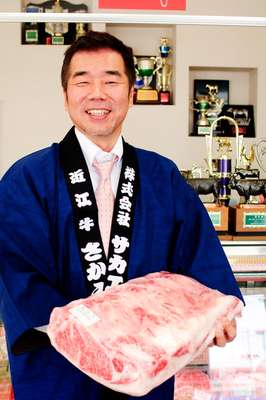
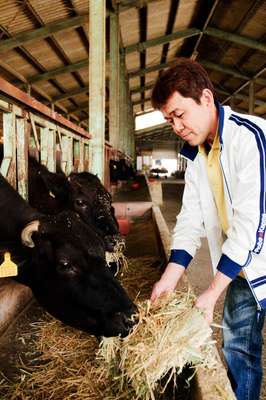
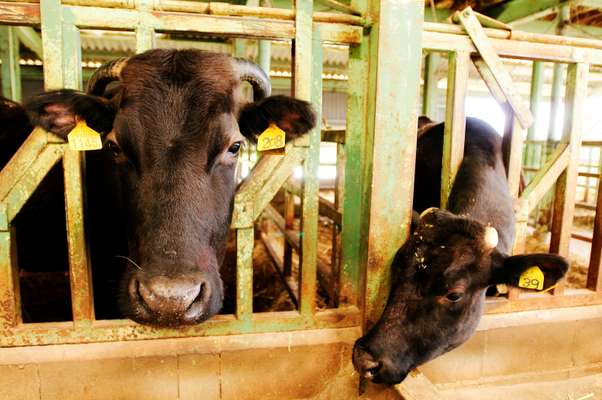

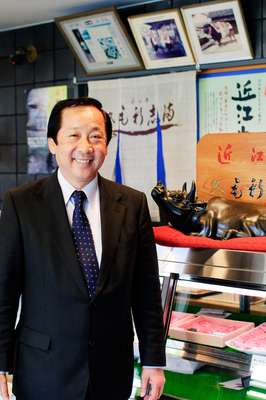
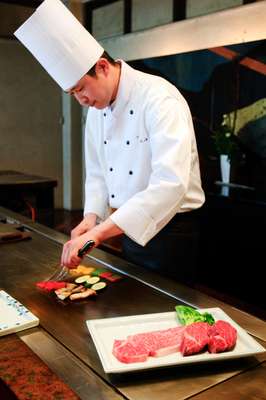

“They want to learn about our farming methods,” he says. “They have the right livestock for Japanese beef, but they don’t know how to prepare the meat.” In the Sakaeya shop, Isamu Kawabata, the head butcher, is slicing into a marbled sirloin. “Omi beef is so soft, that it melts in warm weather or if my hands are too warm,” he says. “You have to cut it quickly.” Cutting the wafer-thin slices needed for sukiyaki, sashimi and shabu-shabu is an art form and takes years of experience.
A short drive away in Dainaka which, a billboard claims, is the “Home of Omi Beef”, is the farm of Yukio Kinoshita and his wife Sonomi. They have a herd of 200 and are one of the three farming couples that work with Niiho. Yukio inherited the farm from his father, whose stock was all Holstein cows. After the deregulation of imports and then the BSE crisis, the Kinoshitas decided to switch to locally bred Omi beef. “It’s so much more satisfying breeding the cows ourselves,” he says.
Japanese beef cows are not put out to pasture – too much frolicking and the meat turns tough, so only the mothers and calves go out. Webcams mean the family can keep an eye on their cows via their mobile phones even when they’re not at home. There’s much talk about Japanese farmers feeding beer to their cows and massaging them to make their meat even more tender. “I’ve tried it but I’m not sure it made a difference to the meat,” says Yukio.
“Even if you did nothing, the meat marbles naturally.” And what about the farmers who play Mozart to keep their cows relaxed? “I used to play music to them but I found the cows got over-excited so we stopped that.”
The Kinoshitas’ 19-year-old daughter, Mina, is studying agriculture at university and works at the farm in the afternoons with her fiancé, Takahiro. She plans to work at the farm full-time. “It’s better if we don’t do things that interfere with the natural development of the cows.” Their second daughter, still at high school, looks set to follow. “I’m lucky my family is involved in the farm,” says Yukio. “It means we can expand.”
The proof of the meat is in the eating, so no day in Shiga would be complete without a beef dinner. The most historic beef restaurant in Japan is Morishima, which was founded in Tokyo in 1879 by two brothers from Shiga. They built up an impressive chain and cultivated Japan’s taste for eating beef. During the war, they had to retreat back to Shiga and the family business is still there, run by Haruo Morishima and his brother Tokuo. They have two restaurants, serving Omi beef from their own farm. Tokuo’s preferred cooking style for newcomers to Omi is ishiyaki-lightly cooked on a hot stone.
“The roots of Kobe, Matsuzaka and Omi beef are the same,” says Yukio, “but the way they’re raised is different. There’s the climate and the feeding but the big difference is the timing – we feed them until they stop wanting to eat; in other areas they keep on feeding them until they look like yokuzuna [sumo champions]. Omi is a good meat for people who like the marbling without the fat.”
He is right – the steak is light yet soft and, as promised, there is no post-prandial heaviness. “There are a lot of farmers in this area. I know how much effort they put into the beef so when they come in here, I want to do my best for them.”
Yukio Kinoshita eats beef every day. “I like to eat my own beef to see how it turned out,” he says. “If I’ve tried something different in the farming I know how it affects the taste.” And how does he recommend cooking it? “I prefer to eat it raw, sashimi-style. That way I can really taste it.”


